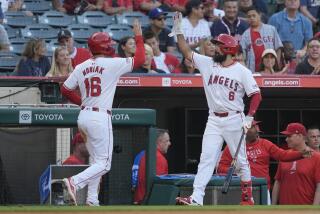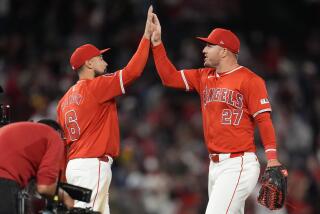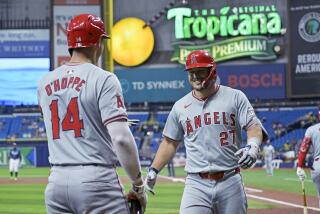Angels Will Make Early Pitch With Six Starters
Some of the best trades are the ones that aren’t made.
In a normal spring, the Angels might have dealt one or more of their six starting pitchers to acquire offensive help. But in this lockout-shortened spring, keeping all six looms as the best decision General Manager Mike Port never made.
With half the time to prepare for the season, pitchers are likely to have less stamina than after a six-week camp and capable of pitching fewer innings when the season starts. The more proven starters a team has, the better its chances might be in the early going.
“With the depth we have, everybody was thinking the Angels were going to be making some trades in spring training, but now they can wait until mid-April,” first baseman Wally Joyner said. “Everybody we sent out on the mound is going to have big-league experience. We still have six great starters. Maybe that was smart. Somebody knew what they were doing holding on to all the pitchers.”
Bert Blyleven agreed that the Angels could benefit more from the shortened spring training than teams that aren’t as dependent on their pitching. Blyleven, Mark Langston, Kirk McCaskill, Chuck Finley, Mike Witt and Jim Abbott make up the starting staff.
The Angels will begin training in Mesa, Ariz., where they usually opens before going to Palm Springs. How long they will stay in Mesa remains to be determined, but it is likely they will move to Palm Springs in time to pick up the last three games of their exhibition schedule March 26-28 against San Diego.
“It might help us out even more because we have an abundance of pitching,” said Blyleven, who joked that he has had his bags packed for a month. “It’s not like one team is going to be ahead. As far as innings pitched, everybody is going to be in the same boat.”
Lance Parrish said the Angel pitchers might not even be far behind where they would be at this stage of an uninterrupted spring training. All of the pitchers have been throwing regularly, most frequently at UC Irvine but occasionally at colleges and high schools around Orange County.
“These are mostly experienced guys, and at this point of their careers they know exactly how to open themselves up as far as preparing and I’m sure they’ve been doing just that,” he said. “These are guys who know their schedules and how to work.”
Parrish and Joyner expected the hitters to have a tougher time getting started than the pitchers.
“I don’t imagine too many guys have been facing game-type pitching. I haven’t hit off pitching yet, just the hitting machine,” Parrish said. “There’ll be a little bit of an adjustment there.”
Joyner: “The transition from batting practice pitching to live pitching might take two weeks, 2 1/2 weeks. It depends on the player. As far as myself, I’ve got the blisters on my hands already.”
More to Read
Go beyond the scoreboard
Get the latest on L.A.'s teams in the daily Sports Report newsletter.
You may occasionally receive promotional content from the Los Angeles Times.






